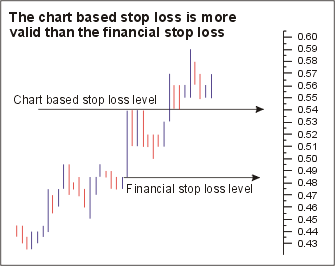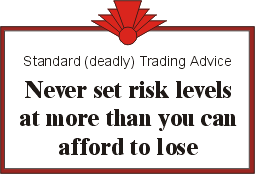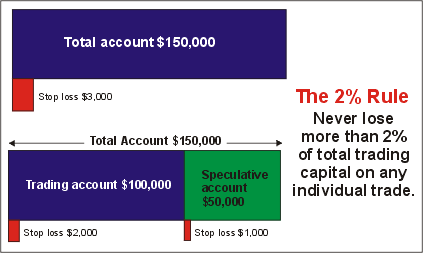- China Trading Statistics
- Darvas Trading
- GMMA Breakout Behaviour
- Happy Easter Holiday
- Holiday Trade Management
- Managing Profitable Trades
- Measuring Returns
- News and Profits
- Placing the CBL Stop
- Recovery made in China
- Secrets of Gold
- The difference between trading
and investing - Trade Exit
- Trading Briefs
- Trading Halt
- Trading IPO's
- Trading Psychology - Getting Perspective
- Using a Private Index
- Using Effective ATR Stops
- Using Equivolume
Articles include:
Handling losses is always difficult and there is some truth in the old market story about how to learn to trade. It suggests that you start by dropping a $50 note over the balcony and onto a busy footpath. The objective is to develop the ability to calmly watch a complete stranger pick up this gift. This training continues until you are able to give away hundreds of dollars to complete strangers without getting too emotional. The objective is to develop a tolerance for small losses so that when it comes time to act to lock in a small loss on a stop loss on your trade you will be able to act.
The story has more than a grain of truth in it. On the one hand we do not want to rush to exit a trade when we lose just a few dollars. Hence the need to become accustomed to giving away $300 to $600 at a time. On the other hand, if the devil-may-care training is too effective it may mean we sit on growing losses without taking any action.
The challenge is to accept a loss, and act with discipline to prevent it growing beyond preset bounds. The next challenge is to decide what level of loss is appropriate. We talk of the 2% rule as our basic money management and stop loss technique. It is vital, but it is also commonly misunderstood in a way that impacts on our ability to handle different types of trades.
The 2% rule tells traders that they cannot let the dollar loss on any individual trade exceed 2% of their total trading capital. This is the maximum amount that can be lost. It is very OK to lose less than 2% of capital. In fact it is very desirable that losses are limited to less than 2% because it improves trading performance dramatically if the financial stops have been matched with a higher logical chart based stop loss point.

It is not OK if the trader does not act on the logical chart based stop loss point because he knows that he can afford to let prices drop even lower before the financial 2% stop loss point is hit. Just reading this makes it sound like a platitude - a problem that even the novice trader knows how to avoid. But is it?
Acting on a stop loss signal is one of the most difficult aspects of trading. The stop loss locks in a loss. A loss attacks our feeling of success. It appears to show that we have made a mistake, and psychologically we resist this. I use automatic intra-day stop loss points to help overcome the temptation to adjust trend lines, to give price latitude and the benefit of the doubt. I use this because I know that when a stop loss is triggered on an end of day chart that I am quite capable of spending a lot of time coming up with really good reasons why I should not act on the stop.
When theory meets practice, it is often overwhelmed. Our inclination is not to admit a mistake. We see this in public life, where often the first responses when people are caught in a dishonest act is to deny and lie in the hope they can get away with it. When did you last 'fess up' when you did something wrong? Its not an irrelevant question, because when prices drop through our stop loss we tend to think we have made a mistake, and our first reaction is to cover up the mistake by ignoring it- we deny. The stop is triggered, but we do not act. What makes this really easy is that this mistake need never be known by anybody. We didn't tell our broker about our intended stop loss point, and we didn't tell our partner. It looks like a victimless crime, except that our trading success ends up being the victim. We lie to ourselves.
As traders we change over time. We are not quite the same person after 5 years of trading as we were when we first started. Our experiences in the market change the way we approach the market. Our experiences in life also effect the way we understand and participate in the market.
Our inconsistent approach to stop loss points is effected by these long term changes, and also by immediate environmental events. Our stop loss discipline is always under attack from a multitude of sources. A string of successful profitable trades may encourage us to ignore a stop loss exit signal. We can afford to give some money back. Perversely, a string of trades where stops are hit may encourage us to ignore the next stop because we can no longer stand the pain of these small losses and the continued onslaught against our ability to successfully select a profitable trade.
When we experience profoundly emotional events, it does impact on our trading, even though we may not be consciously aware of it. In 1998, my office, books, and research were washed away in the Katherine flood, along with hundreds of other homes. I believed that I had coped well with this disaster, but my trading records over the next 6 months show otherwise. My capacity for risk had changed dramatically. Trades that I used to be comfortable with were now uncomfortable. I cut profits short, and let losses run. And there was always a different excuse for each disaster.
I keep records of all trades and examine them so I can establish patterns of destructive behaviour, and of positive behaviour. Within a few months the objective evidence was in my trade records. I could not return to my old levels of risk tolerance, so I had to adjust my trading strategies to take into account my new risk tolerance.
Traders who lost friends on September 11, or who went through the Canberra bushfires, or have been involved in a car accident, will all find a change in risk tolerance levels. We need to be alert for these changes.

The 2% rule sets the maximum we can afford to lose on a single trade. It has another hidden disadvantage. The rule assumes that the total trading capital is applied to the same type of trading opportunity. Lets assume for a moment that we have $150,000 in total trading capital. The 2% rule says we can afford to lose a maximum of $3,000. This is not a problem if all our trades are simple trend trades which normally last from 4 to 12 weeks. These types of trades are easily identified and managed using just a simple combination of two moving averages. Its not brilliant trading, but it is steady, predictable, consistent trading. Setting a stop loss at $3,000 is a good solution.
Unfortunately very few traders, or investors, use just a single style. There are times when we want to chase a speculative stock, trade a fast moving momentum trade, apply an overnight gap strategy, or chase a blue chip breakout from a downtrend. We all have several trading styles, and the $3,000 stop loss limit may not be appropriate for each of these styles.
The solutions usually include reducing our position size so the size of the loss is reduced by the time our stop loss is hit. We looked at these position size manipulation approaches last week. We simply buy less stock, or we buy closer to the stop loss point, perhaps reducing the potential loss to $1,000. These are good solutions in theory, but they can fall down in practice because at the back of our mind we know we can 'afford' to lose $3,000. Remember, our tendency is to first deny, and then lie to ourselves. In the market this means ignoring a stop loss point.
A better solution is found be recognising the sometimes radically different trading approaches that we want to take. These fall into broad divisions between position trading and speculative trading. Readers who consider themselves as investors might divide their activity into investing and trading.
The important feature is that the two activities demand a different level of risk management. The 2% rule is still appropriate, but the dollar value used may not be appropriate to the trading style being used. A $3,000 loss on a speculative trade in BGF is not the equivalent to a $3,000 loss in a slow moving blue chip stock because the probability of the loss is substantially different. One strategy carries a higher risk of failure than the other.

The diagram shows a useful solution. By splitting the total trading capital into two segments we can apply a more appropriate risk level to the different styles of trading. If we allocate $100,000 to position trading or investment, then the dollar loss is reduced to $2,000. If we allocate $50,000 to speculative trading then the dollar risk is reduced to $1,000.
There is a danger in this split. Some people who make this division consider the speculative money as money they can afford to lose. This is risk money. Instead of limiting risk to 2% of this value, $1,000, they believe the entire $50,000 is risk money. This reflects the often quoted, but dangerously misleading advice, to never use money in the market that you cannot afford to lose. Take this approach with you to the market and beyond doubt, you will lose all your cash because you simply do not care about it. After all, you have told yourself you can afford to lose it. It is unwise to underestimate the psychological impact of believing that you are playing with money you can afford to lose. The same impact occurs when we believe we are playing with the markets money generated by a series of winning trades.
Dividing your trading capital into two separate accounts makes it easier to accept that the risk on the trade is $2,000 or $1,000. This risk can be reduced further by applying the position size and entry modifications discussed in last weeks article. By treating each account as separate it is easier to consider the dollar risk appropriate to each style of trading. Mentally it is easier to accept that the maximum allowable risk on a speculative trade is $1,000. In a combined account of $150,000, we may decide the risk limit is $1,000, but we know that we can afford $3,000. When it comes time to act, it may be more difficult.
In an account where all trade calculations are based on $50,000 we have already mentally accepted that $1,000 is the maximum allowable risk. It becomes easier to act when the stop loss is hit and this may contribute to more success in this style of trading.
Our psychological changes are often beyond our control. It takes a lifetime to develop behavioural habits, and they are very difficult to modify. Many people find it difficult to sustain the eating changes necessary to follow a proven and successful diet. Many people find it impossible to fundamentally change lifestyles even after their first heart attack and with the very real threat of a death sentence. It is unrealistic to expect that we can change a lifetime of psychological behavioural patterns when we come to the market.
However, if we recognise these behaviours we can take steps to minimise their impact on our trading. We don't stop the behaviour, we just make sure that we limit the damage it can cause. If we know that we defer our stop loss decision until we reach our maximum dollar loss then there is no point in setting up a trade that asks us to act before this figure is reached, the odds are that we will not act. By establishing a separate trading, or speculative account, and basing all stop loss calculations on the smaller account figure we are able to allow our behaviour - let stops run to the maximum dollar loss - to continue but without inflicting damage on our total universe of market activity. It helps us to get a better perspective on the trade. It is not a universal solution, but some readers might find it useful.